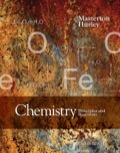
Concept explainers
Calculate [OH-] and pH in a solution in which the hydrogen sulfite ion, HSO3-, is 0.429 M and the sulfite ion is
(a) 0.0249 M (b) 0.247 M
(c) 0.504 M (d) 0.811 M
(e) 1.223 M
(a)
Interpretation:
The molality of HSO3- ion is 0.429 M and that of
Concept Introduction :
From the hydrogen ion concentration, the concentration of hydroxide ion can be calculated as follows:
Here,
From the hydrogen ion concentration, the pH of the solution can be calculated as follows:
Answer to Problem 10QAP
Explanation of Solution
For, a buffer solution, the concentration of H+ can be calculated using the following equation:
Ka = equilibrium constant,
[HB] = concentration of weak acid.
[B-] = concentration of conjugate base.
Since,
The pH of a solution can be calculated using the formula:
pH = -log[H+]
In a buffer, the weak acid HB is the hydrogen sulfite while the conjugate base is sulfite ion.
The concentration of the sulfite ion [SO32-] is 0.0249 M. substituting the given values in equation (1)
pH of the buffer is calculated using equation (3) as follows:
[OH-] is calculated using equation (2) as follows:
So, the pH of the solution is 5.99 and [OH-] is
(b)
Interpretation:
The molality of HSO3- ion is 0.429 M and that of
Concept Introduction :
From the hydrogen ion concentration, the concentration of hydroxide ion can be calculated as follows:
Here,
From the hydrogen ion concentration, the pH of the solution can be calculated as follows:
Answer to Problem 10QAP
Explanation of Solution
The concentration of the sulfite ion [SO32-] is 0.0247 M. substituting the given values in equation (1)
pH of the buffer is calculated using equation (3) as follows:
[OH-] is calculated using equation (2) as follows:
So, the pH of the solution is 6.98 and [OH-] is
(c)
Interpretation:
The molality of HSO3- ion is 0.429 M and that of
Concept Introduction :
From the hydrogen ion concentration, the concentration of hydroxide ion can be calculated as follows:
Here,
From the hydrogen ion concentration, the pH of the solution can be calculated as follows:
Answer to Problem 10QAP
Explanation of Solution
The concentration of the sulfite ion [SO32-] is 0.504 M. substituting the given values in equation (1)
pH of the buffer is calculated using equation (3) as follows:
[OH-] is calculated using equation (2) as follows:
So, the pH of the solution is 7.29 and [OH-] is
(d)
Interpretation:
The molality of HSO3- ion is 0.429 M and that of
Concept Introduction :
From the hydrogen ion concentration, the concentration of hydroxide ion can be calculated as follows:
Here,
From the hydrogen ion concentration, the pH of the solution can be calculated as follows:
Answer to Problem 10QAP
Explanation of Solution
The concentration of the sulfite ion [SO32-] is 0.811 M. substituting the given values in equation (1)
pH of the buffer is calculated using equation (3) as follows:
[OH-] is calculated using equation (2) as follows:
So, the pH of the solution is 7.50 and [OH-] is
(e)
Interpretation:
The molality of HSO3- ion is 0.429 M and that of
Concept Introduction :
From the hydrogen ion concentration, the concentration of hydroxide ion can be calculated as follows:
Here,
From the hydrogen ion concentration, the pH of the solution can be calculated as follows:
Answer to Problem 10QAP
Explanation of Solution
The concentration of the sulfite ion [SO32-] is 1.223 M. substituting the given values in equation (1)
pH of the buffer is calculated using equation (3) as follows:
[OH-] is calculated using equation (2) as follows:
So, the pH of the solution is 7.68and [OH-] is
Want to see more full solutions like this?
Chapter 14 Solutions
EBK CHEMISTRY: PRINCIPLES AND REACTIONS
- Consider a 0.33 M solution of the diprotic acid H2X. H2X H+(aq)+ HX(aq)Ka1=3.3 10 4 HX H+(aq)+ X2(aq)Ka2=9.7 10 8 Calculate the pH of the solution and estimate [HX-] and [X2-].arrow_forwardThe pOH of a basic solution is 3.85. What is pH?arrow_forwardIf the pOH of a solution is 4.21, what is its pH?arrow_forward
- The hydronium ion concentration of vinegar is approximately 4 × 10−3 M. What are the corresponding values of pOH and pH?arrow_forwardThe pH of an aqueous solution of 0.236 M sodium cyanide, NaCN (aq), is This solution is acidic, basic, netural.arrow_forwardThe pH of 0.0720M solution of a weak acid is 2.670. What is the Ka of the acid.arrow_forward
- Determine the pH of an aqueous solution of KOH at 25oC if it is 5.00 x 10-8 M in KOH. Hint: Consider the auto ionization of water.arrow_forwardThe concentration of CH3COOH (pKa=4.75) in vinegar is about 1.0 M. With this what do you predict the pH of vinegar to be?arrow_forwardThe pH of a 0.550 M of weak base, A-, is 9.93 at 25. What is the Kb of the base?arrow_forward
- Given that the pH of a solution is 6.7, what is the [H3O+]?arrow_forwardThe CO2 we breathe reacts with water in our blood to form the weak acid H2CO3. What mole ratio of H2CO3/HCO3− is required to obtain a pH of 7.40, the pH of blood? (Assume that the Ka of H2CO3 is 4.4 ✕ 10−8.)arrow_forwardThe pH of an aqueous solution is 5, what would be the pOH of this solutionsarrow_forward
 Chemistry: Principles and ReactionsChemistryISBN:9781305079373Author:William L. Masterton, Cecile N. HurleyPublisher:Cengage Learning
Chemistry: Principles and ReactionsChemistryISBN:9781305079373Author:William L. Masterton, Cecile N. HurleyPublisher:Cengage Learning Chemistry & Chemical ReactivityChemistryISBN:9781337399074Author:John C. Kotz, Paul M. Treichel, John Townsend, David TreichelPublisher:Cengage Learning
Chemistry & Chemical ReactivityChemistryISBN:9781337399074Author:John C. Kotz, Paul M. Treichel, John Townsend, David TreichelPublisher:Cengage Learning


